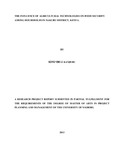| dc.description.abstract | The Kenya Vision 2030 is a vehicle for accelerating transformation of Kenya into a rapidly Industrializing middle-income nation by the year 2030.The Vision 2030 recognizes the role of science, technology and innovation in a modern `economy, in which new knowledge plays a central role in wealth creation, social welfare and international competitiveness. It is reported that fifteen million (approx. 50 %) of Kenyans are food insecure with three million supplied with food relief throughout the year (Kaloi etal, 2005). As a result of this food security concern, the government and lead agencies in agricultural sector came up with agricultural technologies like indoor mushroom production, green house horticultural production, organic farming and plot based Jatropha production among others, in attempt to address this alarming problem. The study assessed the influence of agricultural technologies on food security among households in Lanet and Barut Divisions of Nakuru District. The objectives of the study were to assess indoor mushroom production and food security among households, determine influence of green house horticultural production and food security, assess influence of plot based Jatropha production and food security and finally assess influence of organic farming on food security among the households. The study was based on diffusion of innovation theory. The study used a descriptive survey design. The population of the study was 10,423 households. A sample of 212 respondents was considered with 200 households (145 households from Lanet Division and 55 households from Barut Division), 6 group leaders and 6 extension staff. This sample was picked using stratified random sampling and proportionate sampling. Questionnaires were used to collect data. Pilot testing was carried out in 10 households before the commencement of the study and errors in the data collection instruments were corrected. Data analysis was done using Statistical Package for Social Sciences and Ms Excel. Descriptive statistic was computed and data presented using tables. In the first objective, the study showed that 12 respondents practised indoor mushroom farming and produced 1909.5 Kilgrammes which generated 235,006 Kenya shillings. The consumption of mushroom is 1-200kgs per year which is low despite its high nutritive value. In the second objective, the study has shown that 21 respondents practised green house horticultural farming, produced 76,509 Kilogrammes worth 3,650,007 Kenya shillings. Majority of respondents (11) planted only tomatoes in their green houses. Lack of capital hindered 82 respondents from practicing green house horticultural production. In the third objective, the study has shown that plot based Jatropha production was practised by 10 respondents who produced 252.5 Kilogrammes of Jatropha seeds worth 7,502.5 Kenya shillings. In the fourth objective, the study showed that organic farming is practiced by 199 respondents and besides improving soil fertility, it generated 74,003 Kenya shillings from sales. Organic farming was ranked as the most important agricultural technology in the area of study. The study also showed that indoor mushroom production, green house horticultural production, plot based Jatropha production and organic farming influence food security status in the study area. These agricultural technologies produce food, income and act as a source of employment in the study area. The research findings generated information which will be used by farmers, government agencies and other stakeholders to understand agricultural technologies and their influence towards food security among households. | en |

